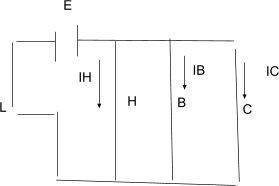
Physics, 21.04.2020 18:55 MarishaTucker
During the experiment, you adjusted the length of the rheostat LL6 so that 1 glow flowed through bulb H. Now that we have seen that the (conduction) current measured by a DMM corresponds to the same physical concept as ‘glow’, it makes sense to ask "what current goes through bulb H when 1 glow goes through bulb H?" The consensus in the past has been about 30 mA but you might have been using a slightly larger or smaller current. Remember that you assumed that the bulbs in circuit 7 were identical. If the resistance of rheostat LL6 has been adjusted so that 30 mA flows through bulb H then what current flows through bulb B? What current flows through bulb C?

Answers: 1
Another question on Physics

Physics, 22.06.2019 16:00
From the perspective of an employee that effective channeling of work related information and concerns
Answers: 1

Physics, 22.06.2019 17:30
Patricia is trying to compare the average rainfall of new york to that of arizona. a comparison between these two states for the months of july through september would best be measured in
Answers: 3

Physics, 22.06.2019 19:30
The ability to make things happen is also called a. heat b. force c. matter d. energy
Answers: 1

Physics, 23.06.2019 01:00
Which statement is true about an object that is moving in a circular motion due to centripetal force, f, when the radius of its circular motion is doubled? the new force then becomes equal to 2f the new force then becomes equal to f the new force then becomes equal to f/2 the new force then becomes equal to f2 the new force then becomes equal to 1/f
Answers: 1
You know the right answer?
During the experiment, you adjusted the length of the rheostat LL6 so that 1 glow flowed through bul...
Questions



Computers and Technology, 13.03.2020 23:22









Computers and Technology, 13.03.2020 23:23






Mathematics, 13.03.2020 23:24






